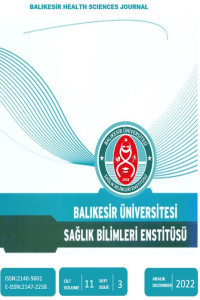ALTMIŞ YAŞ VE ÜZERİ HASTALARDA RADİUS ALT UÇ KIRIKLARININ KONSERVATİF TEDAVİSİNİN KLİNİK VE RADYOLOJİK OLARAK SONUÇLARI
Radius alt uç kırığı, Konservatif tedavi, Kemik yoğunluğu, El bileği, Yaşlı hasta
CLINICAL AND RADIOLOGICAL RESULTS OF CONSERVATIVE TREATMENT IN FRACTURES OF DISTAL RADIUS IN THE PATIENTS 60 OR MORE YEARS OLD
___
- 1. Crilly RG, Delaquerriere RL, Roth JH, et al. Postural stability and Colles’ fracture. Age Ageing. 1987;16:133–8.
- 2. Lafontaine M, Delince P, Hardy D, et al. Instability of fractures of the lower end of the radius: apropos of a series of 167 cases. Acta Orthop Belg. 1989;55:203–16.
- 3. Bucholz RW, Heckman JD, Court B, Charles M; Fractures of the distal radius and ulna. Rockwood and Green's Fractures in Adults, 6. Edition 2006 Lippincott Williams and Wilkins.
- 4. Diego L. Fernandez. Closed manipulation and casting of distal radius fractures. Hand Clin 21 (2005) 307-16.
- 5. McQueen M, Caspers J. Colles' fracture: does the anatomical result affect the final function? J Bone Joint Surg 1988;70(4):649-51.
- 6. Jenkins NH, Mintowt-Czyz WJ. Mal-union and dysfunction in Colles' fracture. J Hand Surg Br 1988;13:291-3.
- 7. Beumer A, McQueen MM. Fractures of the distal radius in low-demand elderly patients: closed reduction of no value in 53 of 60 wrists. Acta Orthop Scand. 2003;74:98–100.
- 8. Young BT, Rayan GM. Outcome following nonoperative treatment of displaced distal radius fractures in low-demand patients older than 60years. J Hand Surg [Am]. 2000;25:19–28.
- 9. Karnezis IA, Panagiotopoulos E, Tyllianakis M, et al. Correlation between radiological parameters and patient-rated wrist dysfunction following fractures of the distal radius. Injury. 2005;36:1435–9.
- 10. Rohit Arora, Markus Gabl, Martin Gschwentner, Christian Deml, et al. AComparative Study of Clinical and Radiologic Outcomes of Unstable Colles Type Distal Radius Fractures in Patients Older Than 70 Years: Nonoperative Treatment Versus Volar Locking Plating: J. Orthop Trauma 2009;23:237-42.
- 11. Barton T, Chambers C, Bannister G. A comparison between subjective outcome score and moderate radial shortening following a fractured distal radius in patients of mean age 69 years. J Hand Surg [Br]. 2007;32:165–9.
- 12. Altissimi M, Antenucci R, Fiacca C, et al. Long-term results of conservative treatment of fractures of the distal radius. Clin Orthop RelatRes. 1986;206:202–10.
- 13. Anzarut A, Johnson JA, Rowe BH, et al. Radiologic and patient-reported functional outcomes in an elderly cohort with conservatively treated distal radius fractures. J Hand Surg [Am]. 2004;29:1121–7.
- 14. Jorge L. Orbay, Diego L. Fernandez. Volar Fixed-Angle Plate Fixation for Unstable Distal Radius Fractures in the Elderly Patient. J Hand Surg 2004;29A/1:96-102.
- 15. Gessensway D, Putnam MP, Mente PL, Lewis JL. Design and biomechanics of a plate for the distal radius. J Hand Surg 1995;20A:1021–7.
- 16. Jupiter JB, Morent Huben M. Operative management of distal radial fractures with 2.4 milimeter locking plates. A multicenter prospective case series. J. Bone Joint Surg. Am. 2009 Jan;91(1):55-65.
- 17. Orbay JL, Fernandez DL. Volar fixation for dorsally displaced fractures of the distal radius: a preliminary report. J Hand Surg 2002;27A:205–215.
- 18. Kambouroglou GK, Axelrod TS. Complications of the AO/ASIF titanium distal radius plate system in internalfixation of the distal radius: a brief report. J Hand Surg 1998;23A:737–41.
- 19. Jupiter JB, Ring D, Weitzel PP. Surgical treatment of redisplaced fractures of the distal radius in patients older than 60 years. J Hand Surg 2002;27A:714–23.
- 20. Mudgal CS, Jupiter JB. Plate fixation of osteoporotic fractures of the distal radius. J. Orthop. Trauma 2008 Sep;22/8 (Suppl):s106-15.
- ISSN: 2146-9601
- Yayın Aralığı: Yılda 3 Sayı
- Başlangıç: 2012
- Yayıncı: Balıkesir Üniversitesi
GEBELİKTE PELVİK TABAN KAS EGZERSİZİ
Şahver Ege HİŞMİOĞULLARI, Adnan Adil HİŞMİOĞULLARI
SIÇANLARDA BEYİN PREFRONTAL KORTEKS DOKUSU ÜZERİNE OMEGA - 3 YAĞ ASİTLERİNİN KORUYUCU ETKİSİ
Burak GÜLCEN, Ömür KARACA, Murat Abdulgani KUŞ, Emrah ÖZCAN, Dilara KAMAN, Murat ÖGETÜRK, İlter KUŞ
Ali TURGUT, Cemil KAYALI, Burak GÜNAYDIN, Seydi Ahmet EREN, Levent SÜRER, Önder KALENDERER
PERİFER DEVLET HASTANESİNDE MİNİ-PERKUTAN NEFROLİTOTOMİ UYGULANABİLİRLİĞİ: DENEYİMLERİMİZ
Ercan KAZAN, Cem KEZER, Alaaddin Akay, Seyfettin ÖRGEN, Rahmi ASLAN, Mustafa Cengiz ZAMAN
Filiz ALTIPARMAK, Selma TURAL HESAPÇIOĞLU
PERONEAL ARTER PSÖDOANEVRİZMASINDA BT ANJİOGRAFİ BULGULARI: OLGU SUNUMU
Erdoğan BÜLBÜL, Gülen DEMİRPOLAT, Orçun GÜRBÜZ, Abdülkadir ERCAN, Bahar YANIK
